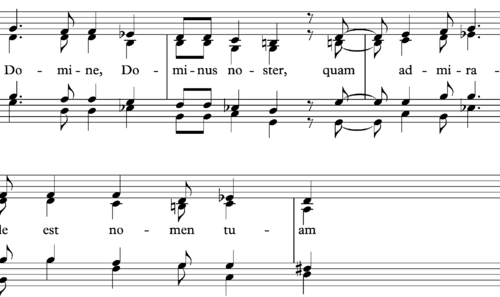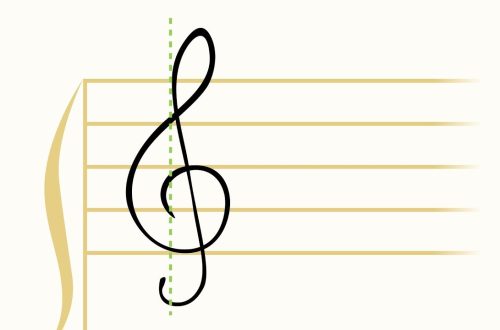
Pauses in music: their name and spelling
Contents
In the musical rhythm, not only sounds of different durations play an important role, but also moments of silence – PAUSES. Rests have exactly the same names as note durations: there is a whole note and there is a whole rest, a half duration and a half rest, and so on.
If you have forgotten what different note durations look like and what information they convey to the musician, you can refresh your knowledge HERE. The names of durations must be kept in mind by anyone who wants to fully understand musical notation. But for recording pauses in notes, there are also special graphic signs.
Types of pauses and their spelling
Look at the picture below and memorize the names and appearance of the signs that indicate pauses.
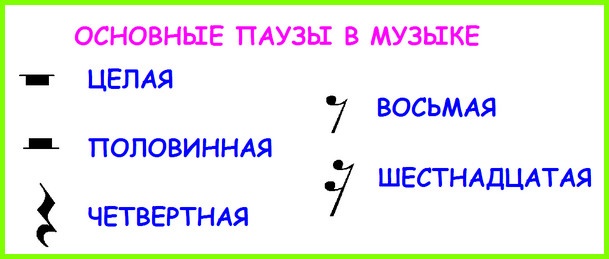
WHOLE PAUSE – in sound (in its silence) it corresponds to a whole note, that is, its duration is four counts or four beats of the pulse (if the pulse beats in quarter notes). In writing, a whole pause is a small filled rectangle, which is “suspended” under the fourth line of the stave. In rare cases, a whole rest can be shifted up or down, sometimes it is also recorded separately. Then the most important thing is to write it under the ruler (as if under an additional one).
HALF PAUSE – in duration it is equal to a half note, that is, it is calculated for two beats of the pulse. Interestingly, in terms of writing, this is exactly the same rectangle as that of a whole pause, only it “lies” on the third line of the staff. And in the case of an offset or a separate entry, it simply lies above the ruler.
TIP. Many novice musicians confuse a whole pause with a half for a long time, and do not get used to distinguishing between them. This is where a trick will help. Remember that the half rest is located at the point where the stave divides into two halves (on the third line). In moments of doubt, just remember the location of the half pause and all your uncertainty will go up in smoke.
THE FOURTH PAUSE – in time, of course, the same as the quarter, that is, one count or one beat of the pulse. But according to the graphic image, such a pause is somewhat unusual. Few musicians know how to write this rest accurately. To do this, first, the third and fourth lines of the staff are slightly crossed out with an inclination to the left, then these two strokes are connected. It turns out a kind of “lightning”. And then a comma turned upside down is added to this “lightning” from below.
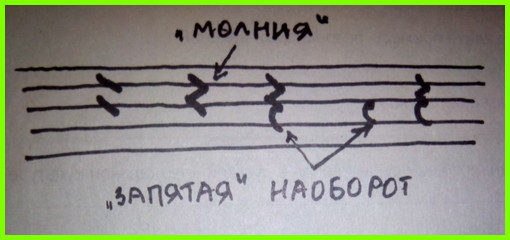
EIGHTH PAUSE – is equal in duration and, according to the method of its calculation, coincides with the eighth note. In writing, it is a peg slightly tilted to the right, to which a “curl” is attached from above, also similar to an inverted comma, only directed with its sharp end upwards, to the top of the peg. This curl-comma can be compared with a tail, that is, with a flag at the eighth note.
THE SIXTEENTH BREAK – in its temporal characteristics is similar to sixteenth notes. It is similar in spelling to the eighth rest, only with two scroll flags. In other words, the graphic representation of eighths, sixteenths and smaller durations is based on the same principle: the more tails, the smaller the duration (the 32nd note and pause have three tails, the 64th note has four, respectively)
How are pauses counted?
 If, when analyzing a piece, you calculate the rhythm aloud, then prepare yourself for the perception of pauses, on which, by the way, the count never stops, because the musical time in the piece flows continuously.
If, when analyzing a piece, you calculate the rhythm aloud, then prepare yourself for the perception of pauses, on which, by the way, the count never stops, because the musical time in the piece flows continuously.
In the picture you can get acquainted with the principles of counting certain pauses. Everything there is similar to how ordinary note durations are considered. A whole pause is considered ONE-AND, TWO-AND, THREE-AND, FOUR-AND, half – up to two (ONE-AND TWO-AND or THREE-AND FOUR-AND). The quarter pause occupies one full account, the eighth – half a share.
The meaning of pauses in music
Pauses in music play the same role as punctuation marks in speech. Most often, pauses delimit musical phrases and sentences from each other. Such separating pauses are also called caesuras.
However, sometimes sounds in a melody are separated by short pauses, this is especially common in vocal opera music. For example, when a composer wants to convey the excited character of a singing character with the help of discontinuity of speech or, for example, wants to show a pointed, sharp musical cue. It happens that in the vocal parts of the heroes of musical narratives, moments of pause are introduced for theatrical reasons (for example, to depict moments of intense reflection).
In instrumental music, pauses are also associated with caesuras, with moments of relaxation of tension in the melodic line. But it happens in a different way, sometimes with the help of pauses, on the contrary, tension accumulates. And sometimes pauses just tear apart the melody from the inside. And this is also an artistic technique. One way or another, the introduction of pauses in a musical text is always justified by the artistic tasks that the composer has set for himself.
Rhythm exercises with pauses
We suggest you practice a little – learn a few rhythms in which pauses will occur. All exercises are accompanied by musical examples and audio recordings so that you can get both visual and auditory representations in parallel.
EXERCISE #1. Here we get acquainted in practice with quarter pauses. First, we suggest that you listen to the uniform beats of the pulse in quarters on the note LA of the first octave. We count to four, in other words – we have a quadruple meter (4 beats of the pulse u4d XNUMX beats).

Further, two variants of the paused rhythm are offered for comparison. In one of the options, every even beat of the pulse will be replaced by a quarter pause, in the other, on the contrary, odd quarters will be replaced by pauses.


EXERCISE #2. Now we will work out quarter pauses in the conditions of a three-part meter. In each musical measure there will be three beats, that is, three beats of the pulse, and, accordingly, it will be necessary to count not up to four, but only up to three. It’s simple, like in a waltz: ONE-TWO-THREE. Each beat of the pulse is a quarter note. The first option is without pauses, on the note of MI. Just feel this rhythm.

In the following examples, quarter pauses fall on different beats: first on the first (the second and third beats are played as quarter notes), then vice versa (on the first beat there is a sound, on the rest there are two pauses).


And now let’s combine these two different rhythms into one score. Let us have two votes. One, lower, in the bass clef will play only the first beats and pause for the next ones. And the other, upper one, on the contrary, will be silent on the first hit and play on the second and third. It should be a mini-waltz. Do you hear?
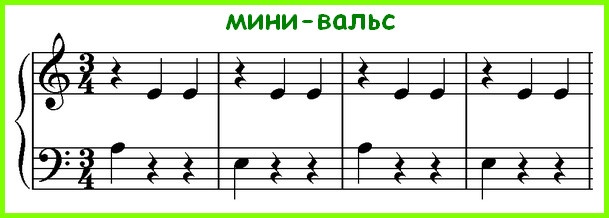
Fixing pauses and durations
If you are studying musical notation with your small child, then it makes sense to fix the topic “Pauses” with written assignments in special copybooks (link is attached below). The samples in these recipes are very large, so it is best to give the baby colored pencils with a thick stem, felt-tip pens or a marker in the hands of the baby. Also, if desired, you can create
NOTES “PAUSES” – DOWNLOAD
Also in classes with children, cards with the image of pauses can be useful. If desired, you can also develop a musical alphabet with pauses. And we have already prepared cards with pauses.
MUSIC CARDS “PAUSES” – DOWNLOAD
Traditional tasks for note durations and pauses are musical and mathematical examples. If you cope with them quickly and with a bang, then please us with your successes in the comments. Success in these tasks indicates that you have mastered the basic rhythmic principles.
Examples with note durations
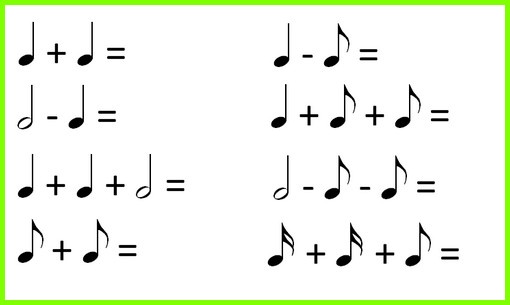
Pause Examples
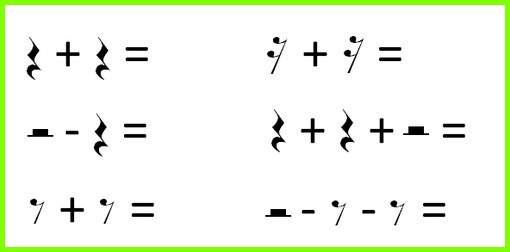
On this note, perhaps, we will stop the lesson for today. Rhythm in music is such a thing that you need to do it all the time, but you can do it endlessly.
In future episodes, you’ll learn how you can use dots and special characters to lengthen regular pauses. In the meantime, if you have any questions, write them in the comments. Your messages will not go unnoticed.
At the end – the traditional “musical pause”. We invite you to listen to the magnificent rhythmic Romanian dances for violin and piano by B. Bartok. Happy listening!




